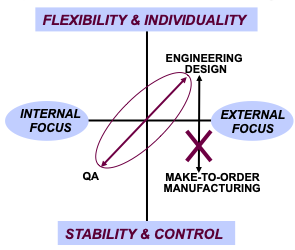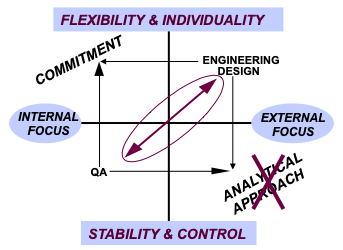
We all know how productive teamwork can be, especially when the team members share the same work environment and business values. We also know how ineffective cross-functional teams can be when forced together with different functional objectives. Is Cross-functional Teamwork an oxymoron?
By Dan Harrison
This anecdote covers a lot of material in a small space. Yet, for those confronting difficulties with cross-functional teams and conflict, it may answer a lot of questions while raising a few others to be addressed later.
Conflict
Many years ago, I began looking under the hood trying to understand what caused cross-functional teams to drown in conflict. I’d read that conflict was good if properly handled, but the magnitude of this conflict had often already reached a breaking point before I was brought in as a consultant to sort it out.
I learned to listen, and to isolate each conflict to just two or three individuals (always representing different functions, it would turn out) so that I could work with them individually, and then, in a very small group. I began to notice that their differences usually arose because these cross-functional teammates were motivated by different business objectives with competing underlying business values. I had to understand this better, so I started investigating available literature.
Competing Values Framework
Having found some references on business values, I began collecting a list of “competing” business values. At workshops I would ask participants to identify which side of each of these pairs best describes how they perform their assigned work. I would also ask them to identify their functional area.
Tables 1 and 2 provide a few of these work-value sets that have been separated into two groups answering questions about the types of work required in most business organizations. How would you characterize your work environment?
|
Table 1: Organizational Maintenance vs.
What values does your job instill? |
Table 2: Agility vs.
How does management react? |
Table 1 addresses the question: “Would you describe your work as focused more on the long-term maintenance of the organization, or on delivery of products and services to customers?” It turned out that a few of these values distinguish between the types of work done in what are often called “Support” and “Line” functions within business organizations.
Note that some paired terms—such as “Support” and “Line”—may have acquired negative connotations. These are not values, and you may want to avoid these terms, or you may need to speak frankly about the origin of prejudices arising from inherent completing business values. In extreme situations, a workshop may be needed.
Table 2 addresses the question: “Do your responsibilities at work encourage you to interact openly with other people, or do these responsibilities tend to focus you more on specific tasks?” These values fundamentally reflect the types of products and services offered by businesses. So, these business values reflect the work that has to be done without regard for the business culture or style of management/supervision. Hence, these resulting different work values can, and do, encourage different management styles, philosophies and even different business cultures.
In the title to Table 2, I recently adopted the modern term, Agility. My next step was to confirm that there was a correlation between my workshop attendees’ functional areas and the quadrants to which their responses mapped. There was!
I had noticed that their responses could easily be represented within a four-quadrant framework based on these two sets of competing business values. Using Organizational Maintenance versus Delivery of Products and Services for the horizontal scale [X-axis], and Agility versus Programmed Tasking for the vertical scale [Y-axis], each individual’s responses could be averaged to produce the coordinates [X, Y] to be mapped to the four quadrants. (Instead of just choosing one or the other value, a scale of 1 to 5 can be used for each value pair to produce a more accurate mapping, with “3” on each axis translated to the origin at [0,0].)
This mapping proved to be very consistent in that respondents within the same functional area were accurately mapped to the same quadrant. Figure 1 shows an example with these functions mapped to the four quadrants but note that in this figure the axes have been relabeled.
As I continued my investigations into the field of Conflict Resolution, I adopted Robert E. Quinn’s Competing Values Framework (CVF) that gives the same result if you re-label the vertical axis: Flexibility and Individuality versus Stability and Control, and the horizontal axis: Internal Focus versus External Focus you have the CVF[1]. My attention then turned to an approach to conflict resolution called Reframing.
Figure 1. Example Mapping of Functions to the Competing Values Framework
Reframing
At first, although the term sounded promising and professional, its application appeared to be vague and difficult, until I put it together with the values embedded in the CVF. My research showed that, as individuals, we tend to accept values in adjacent quadrants of the CVF much easier than opposing values. This suggests that we might be able to “reframe” a conflict grounded in opposing values by focusing on a value in an adjacent quadrant. I had already done this a time or two without knowing the underlying theory. You will have done so as well, especially in familial or social settings, and you will also have done so at work.
The following example is intended to surprise and encourage you to recall that you have actually done this before—at a company picnic or on a golf course, for example. You need not always look for business values to reframe a conflict. Think outside of the box.
Situation: At a division of a major international corporation, a troubled research & development program experienced several field test failures of its prototypes.
- The Government customer expressed serious concerns about the continued viability of the contract issuing a notice to Quit or Cure.
- The program was nearly two years behind schedule with Engineering Design and Manufacturing blaming each other for delays in the delivery of new test prototypes.
Analysis: The newly appointed Test Director investigated and determined:
- Manufacturing and Quality Assurance (QA) complained about the large number and poor quality of Engineering Change Orders (ECO). ECOs had to be revised multiple times before QA would permit manufacturing to proceed.
- A single engineer had been assigned responsibility for the ECOs. Both Nick and his manager heard manufacturing’s complaints and decided that manufacturing was just “nit picking.”
A review of recent ECO’s by the Test Director showed that the details requested by manufacturing were in fact required by the contract. QA had been enforcing these requirements, particularly in view of the recent test failures and numerous quality discrepancies reported from the field. QA was the real party to the conflict (Figure 2)
|
You must correctly identify the parties to a conflict |
This solution shows leadership |
Figure 2. Reframe to resolve the toughest conflicts.
Resolution: Reframing of this conflict would require refocusing on a common value within the upper left or lower right quadrant of the Competing Values Framework.
- The Test Director first attempted an analytical approach with Nick and his manager. Not surprisingly, this was largely unsuccessful as it merely emphasized the cause of the conflict itself—inattention to detail.
- The Test Director knew that he would need Nick’s willing support, his personal commitment, to obtain the extra effort needed from this engineer. The solution was an after-hours basketball game, coupled with the Test Director’s obvious personal commitment to the program.
- This example illustrated in Figure 2 highlights a difference between Management and Leadership. Elevation up the chain of command would have gotten it done, but only temporarily, until this engineer left the company or moved on to another project. And nothing would have been learned.
Conclusion
Is “cross-functional conflict resolution” an oxymoron? Of course not, but breaking out of positions based on values is tough. It helps to be able to recognize where your opponent’s position is coming from. What is their functional role in the organization? What business value is their opposition based upon? In what quadrant of the CVF does this function reside? And yours? How can you reframe the conflict using values in a quadrant adjacent to both of yours? Try it!
[1] I spoke with Professor Quinn a few times by phone in the mid-1990s after recommending him as a consultant to IBM HQ in Atlanta, Georgia.
Dan Harrison is an SMA Principal Associate in our Technical Management & Engineering Services Practice, and has over 35 years of experience in aerospace engineering.
If you’re building a team and you have positions you can’t fill, you need to use SMA Talent on Demand (TOD®)! With TOD®, you can find experienced talent, such as Dan, matched to your exact needs:


